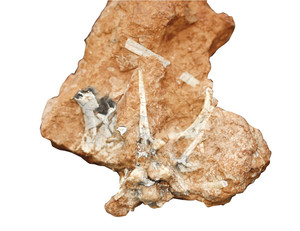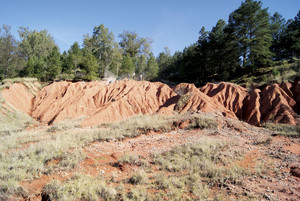 Finding fossils is an important part of a paleontologist’s work—and perhaps the most celebrated—but in many cases, this is only the first step in an intense effort to interpret the echoes of a past so distant that they are almost inaudible. Two recent studies by Brazilian teams have shown how three-dimensional images produced by tomography can be used to reinterpret the habits and characteristics of known fossils, enabling researchers to digitally reimagine the probable movements of animals that lived hundreds of millions of years ago.
Finding fossils is an important part of a paleontologist’s work—and perhaps the most celebrated—but in many cases, this is only the first step in an intense effort to interpret the echoes of a past so distant that they are almost inaudible. Two recent studies by Brazilian teams have shown how three-dimensional images produced by tomography can be used to reinterpret the habits and characteristics of known fossils, enabling researchers to digitally reimagine the probable movements of animals that lived hundreds of millions of years ago.
A paper by paleontologists from São Paulo and Rio de Janeiro suggests that terrestrial locomotion was common among an extinct crocodile species discovered in Monte Alto, São Paulo, in 2004. The hypothesis is based on anatomical analysis of the limbs of the reptile, which lived 80 million years ago. Another study, by paleontologists from the Brazilian states of São Paulo and Minas Gerais and from Germany, reconstructed the brain of a 230-million-year-old dinosaur found in Rio Grande do Sul State, Brazil, in the 1990s. In the article, the authors argue that the creature’s neck was so flexible that it may have been carnivorous, rather than strictly herbivorous, as is typical of the genus to which it belonged.

JAY NAIR
Skull bones of the Saturnalia tupiniquim dinosaur, which lived 230 million years agoJAY NAIRMore than a decade after participating in the discovery of the Montealtosuchus arrudacamposi crocodile fossils, paleontologist Sandra Simionato Tavares, director of the Monte Alto Museum of Paleontology, recreated the animal’s muscle system and joints. In partnership with researchers from the Institute of Radiology at the University of São Paulo’s School of Medicine (FM-USP), she obtained tomographic images of the different parts of the fossil, composed of skull fragments, vertebrae, and a front limb. These images were then sent to research partners at the Renato Archer Information Technology Center (CTI) and the National Synchrotron Light Laboratory (LNLS), both in Campinas, São Paulo, who were able to recreate the reptile’s movements in a virtual environment. The result of this study, which included work by Fresia Ricardi Branco, from the Institute of Geosciences at the University of Campinas (UNICAMP), was published in the journal Cretaceous Research in July this year.
“The studied crocodile shares some characteristics with current species and others with its more distant ancestors,” says Tavares. The mandibular joints of the Montealtosuchus were similar to modern-day crocodiles. However, the nostrils of the extinct species were positioned at the front of its snout and its eyes located on the sides of its head, suggesting that it inhabited terrestrial environments. By examining the tomographic images, the research group led by Tavares looked beyond the described morphological characteristics of the animal and gained a new understanding of its biomechanics. The results of the analyses indicate that the limb posture of the Montealtosuchus was more upright than that of its present-day counterparts, which are largely aquatic.
The extinct crocodile, which measured between 1.3 and 1.5 meters, weighed 25 to 50 kilograms. The digital reconstruction suggests that the joints in the pectoral girdle and anterior appendicular skeleton, which support posture and movement, were distributed so that the limbs could be positioned vertically below the body and not to the side. The 3D reconstruction of the bones suggests that the scapula, coracoid, and humerus were joined and the metacarpals were more compressed and closer together, meaning the crocodile was able to travel long distances on land in search of prey, without depending on large bodies of water or wet environments.

DIVULGAÇÃO
Paleontological site in Rio Grande do Sul, Brazil, where the dinosaur was foundDIVULGAÇÃO“Our understanding of past life on Earth must transcend the simple knowledge of the diversity of existing forms of life,” says paleontologist Ismar Carvalho, from the Institute of Geosciences at the Federal University of Rio de Janeiro (UFRJ) and one of the coauthors of the paper. He believes that evaluating the mechanics of movement and the physiology of these animals allows us to improve ecological interpretations. “The anatomical and physiological solutions identified in animals reflect the ecological spaces in which they lived, but our knowledge is limited by difficulties extracting information from fossils without damaging them. Tomographic images allow us to model the muscle arrangements and insertions, aspects that are difficult to evaluate by simply observing fossil records,” he reports.
It was thanks to advances in computed tomography that researchers from the University of São Paulo in Ribeirão Preto and the Ludwig Maximilian University of Munich were able to analyze in more detail the fossils of the bones that surround the brain, known as the neurocranium, of the Saturnalia tupiniquim. Found in rocks from the Triassic period in the Brazilian state of Rio Grande do Sul, this is one of the oldest dinosaurs in the world. The species is part of the sauropodomorph genus, the same group as the largest terrestrial animals that ever inhabited the planet; long-necked herbivores that were up to 40 meters long and weighed as much as 90 tons. Unlike its more famous relations, however, the Brazilian dinosaur was small, averaging about 1.5 meters in length. As well as plants, it may also have eaten small animals. Reconstructing the internal structure of the skull allowed scientists to estimate the size, shape, and formation of the brain, shedding light on the animal’s eating habits. The analyses provided additional evidence that earlier sauropodomorphs may also have been predators.
 Using digital reconstruction, researchers filled in the fossilized neurocranium and noticed certain areas were larger, such as the flocculus and paraflocculus, which are part of the cerebellum and are related to the control of vision and head and neck movements. “Such developed structures suggest that the animal may have exhibited behavior typical of predators, who use rapid neck and head movements to catch small and agile prey,” says paleontologist Mario Bronzati Filho, the lead author of the article, which includes the results of the analysis and was published in Scientific Reports in September. Bronzati is currently studying a doctorate at the Ludwig Maximilian University of Munich.
Using digital reconstruction, researchers filled in the fossilized neurocranium and noticed certain areas were larger, such as the flocculus and paraflocculus, which are part of the cerebellum and are related to the control of vision and head and neck movements. “Such developed structures suggest that the animal may have exhibited behavior typical of predators, who use rapid neck and head movements to catch small and agile prey,” says paleontologist Mario Bronzati Filho, the lead author of the article, which includes the results of the analysis and was published in Scientific Reports in September. Bronzati is currently studying a doctorate at the Ludwig Maximilian University of Munich.
According to Max Cardoso Langer, from the Department of Biology at USP’s Ribeirão Preto School of Philosophy, Sciences, and Languages and Literature (FFCLRP-USP), this is the first time that parts of the brain of such an ancient dinosaur have been digitally reconstructed. “This study allowed us to better understand habits that are closely related to the evolution of life on Earth, and that are usually inferred based only on the morphology of teeth and other parts of the skeleton,” says the researcher, who was involved in the discovery of the dinosaur in the 1990s. Paleontologist Jonathas de Souza Bittencourt Rodrigues, from the Federal University of Minas Gerais (UFMG), also participated in the Saturnalia study.
Paleontologist Sérgio Alex Azevedo, from the UFRJ National Museum, who did not participate in the studies on the Monte Alto crocodile or the Brazilian dinosaur, believes that while the use of tomography in paleontological research is not new, it has become more effective with the development of higher-resolution technologies. More sophisticated equipment is capable of providing greater detail than medical CT scanners. With fossils, there is no need to worry about strictly controlling radiation levels, since no living organisms are being examined. “It is a non-invasive technique that does not alter the form of the object under analysis. This is fundamental when dealing with materials at risk of natural deterioration, which must not be subjected to mechanical damage. It gives us access to a whole range of previously unavailable information, such as the structures of internal cavities,” he explains.
Project
The origin and dispersal of dinosaurs in Gondwana (Neotriassic – Eojurassic) (No. 14/03825-3); Principal Investigator Max Langer (USP); Grant Mechanism Thematic Project; Investment R$1,959,890.17.
Scientific articles
TAVARES, S. et al. The morphofunctional design of Montealtosuchus arrudacamposi (Crocodyliformes, Upper Cretaceous) of the Bauru Basin, Brazil. Cretaceous Research. July 11, 2017.
BRONZATI, M. et al. Endocast of the Late Triassic (Carnian) dinosaur Saturnalia tupiniquim: implications for the evolution of brain tissue in Sauropodomorpha. Scientific Reports. v. 7, 11931. Sept. 20, 2017.